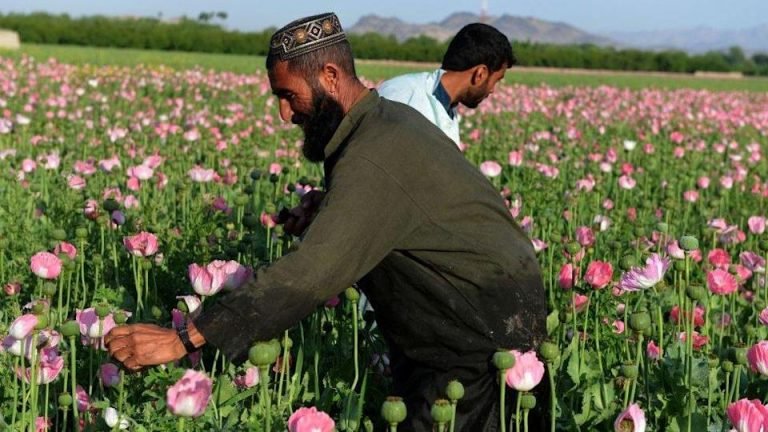The Taliban claims that opium cultivation of opium was stopped and the flow of illegal drugs stopped when it was in power in Afghanistan.

But although there was a sharp decline in 2001 – when it was last under control – the cultivation of opium poppy in Taliban-held areas has increased in subsequent years.
How much opium is produced in Afghanistan?
The opium poppy plant can be refined to form the basis of many highly addictive substances, including heroin.
According to the United Nations Office on Drugs and Crime (UNODC), Afghanistan is the largest producer of opium in the world.
Its opium crop accounts for over 80% of the world’s supply.
In 2018, UNODC estimates that opium production contributed up to 11% of the country’s economy.
The Taliban has said what will it do about opium?
After the Taliban took control of Afghanistan, spokesman Zabihullah Mujahid said: “Drugs were not produced until we were in power.”
“We will bring opium cultivation back to zero” and there will be no smuggling, he said.
What is the record of the Taliban?
First, opium cultivation increased from about 41,000 hectares in 1998 under the Taliban regime to more than 64,000 in 2000, according to the US State Department.
This was mainly in the Taliban-controlled Helmand province, which accounted for 39% of the world’s illegal opium production.
But in July 2000, the Taliban banned the cultivation of opium poppy in areas under their control.
And a United Nations report in May 2001 saw “an almost complete success of the ban in ending opium cultivation in Taliban-controlled areas”.
Following the Taliban’s ban on opium cultivation, there was a significant decline in opium and heroin seizures globally in 2001 and 2002.
However, things have changed since then
Although cultivated in areas recently controlled by the former government, most opium cultivation is concentrated in areas held by the Taliban.
For example, the Taliban-controlled Helmand and Kandahar provinces in southern Afghanistan used the most land for opium cultivation in 2018.
How does the Taliban make money from poppies?
According to the UNODC Afghanistan Opium Survey, opium cultivation is a major source of employment in Afghanistan, and opium harvesting provided about 120,000 jobs in 2019.
The US State Department says the Taliban profit through taxes on the opium crop and indirectly through processing and smuggling. 10% cultivation tax is collected from opium farmers.
Afghanistan: How does the Taliban make money?
Taxes are also collected from laboratories that convert opium into heroin, as well as traders who smuggle illegal drugs.
The Taliban’s annual share in the illicit drug economy is estimated at $100m-$400m.
According to the US watchdog, the Special Inspector General (CIGAR) for Afghan Reconstruction, illegal drugs account for up to 60% of the Taliban’s annual revenue.
Where do the medicines end?
Heroin made from opium grown in Afghanistan makes up 95% of the market in Europe.
However, according to the US Drug Enforcement Agency, only 1% of the heroin supply in the US comes from Afghanistan. Mostly comes from Mexico.
Between 2017 and 2020, more than 90% of opioids were transported by road.
But recently there has been an increase in sea seizures on routes between the Indian Ocean and Europe.
Drugs seized globally
Although there has been ups and downs, opium production and opium-related seizures have shown an upward trend over the past two decades, consistent with opium cultivation in Afghanistan.
According to Cigar, drug seizures and arrests have had minimal impact on the country’s opium poppy cultivation.
Opium seizures since 2008 accounted for just 8% of the opium produced by the country in 2019 alone, it said.

